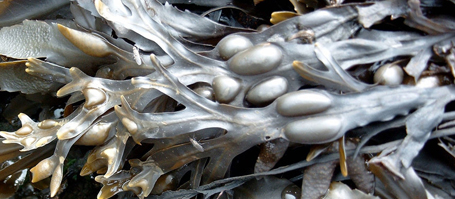The surprising result: The defense proved to be very robust to environmental changes. The study is published today in the international online-journal PLOS ONE.
It is up to 30 centimetres long, it has a green-brown color and is probably known to every beach walker on the North and Baltic Sea: the bladderwrack, a seaweed, which is common on the coasts of the whole North Atlantic area. The bladderwrack provides food and habitat for many other organisms. Its abundance is considered to be an indication of whether a coastal ecosystem is intact or not. Especially in the German Baltic Sea, however, the populations have declined considerably in the past decade. The reasons for this are not yet fully known. "Against this background, it is important to know how environmental changes affect the bladderwrack and why," says biologist Dr. Mahasweta Saha from GEOMAR Helmholtz Centre for Ocean Research Kiel.
As the climate changes, the temperature of the Baltic Sea is rising. The strong input of nutrients in recent years has also led to greater water turbidity and reduced light availability. Therefore, it seems likely that these changes are partly responsible for the decline of bladderwrack populations. But a new study published today in the international science journal PLOS ONE shows that the bladderwrack responds more robustly to these environmental changes than previously thought. "At least the defense against its initial enemies, i.e bacterial foulers that may promote further fouling upon the alga’s surface, works even at high temperatures and long periods of darkness," explains Dr. Saha, who is the lead author of the study.
Bacteria generally play a crucial role in the life of seaweeds. Also the bladderwrack lives in symbiosis with many types of bacteria that feed it with certain growth factors and nutrients. On the other hand, some other bacterial species can harm the seaweed. To deter them, Fucus produces different chemical compounds, as Dr. Saha has shown in some of her previous studies. "Until recently one of these compounds was only known to function as a pigment. That it can also play a protective role, was a sensation," the biologist says.
In order to find out whether the delicate system of defensive substances may be affected by environmental changes, the scientists exposed bladderwrack from the Baltic Sea in controlled environmental chambers to increased average temperatures of up to 25 degrees Celsius. Other specimens were held in open experimental chambers on pontoons in the Kiel Fjord (‘Benthocosms’). "With the help of special foils we created different light conditions - from normal daylight without changes to permanent darkness," says Dr. Florian Weinberger from GEOMAR, co-author of the current study.
In subsequent analyses, the researchers noted that under changed light or temperature conditions the production of single defensive compounds decreased in comparison to unchanged conditions. "But thanks to the mix of defensive substances the defense as a whole remained effective even at the highest simulated temperatures and in total darkness," says Saha.
The Kiel researchers also found that the same substances that fight off harmful bacteria, attract other bacteria useful for the bladderwrack. "This is also a new finding," said Dr. Weinberger.
Overall, the study demonstrates that defense mechanisms and symbiotic relationships in bladderwrack are much more complicated than previously thought, the researchers say. "If we want to understand exactly why the bladderwrack responds to certain environmental changes, we must know better its metabolism and its relationship to other organisms such as the bacteria," says Saha.
References:
Saha, M., M. Rempt, S. B. Stratil, M. Wahl, G. Pohnert, F. Weinberger (2014): Defence chemistry modulation by light and temperature shifts and the resulting effects on associated epibacteria of Fucus vesiculosus. PLOS ONE, http://dx.doi.org/10.1371/journal.pone.0105333
Saha, M., M. Wahl (2013): Seasonal variation in the antifouling defence of the temperate brown alga Fucus vesiculosus. Biofouling: The Journal of Bioadhesion and Biofilm Research, Volume 29, Issue 6,
http://dx.doi.org/10.1080/08927014.2013.795953
Saha, M., M. Rempt, B. Gebser, J. Grueneberg, G. Pohnert, F. Weinberger (2012): Dimethylsulphopropionate (DMSP) and proline from the surface of the brown alga Fucus vesiculosus inhibit bacterial attachment. Biofouling: The Journal of Bioadhesion and Biofilm Research, Volume 28, Issue 6,
http://dx.doi.org/10.1080/08927014.2012.698615
Saha, M., M. Rempt, K. Grosser, G. Pohnert, F. Weinberger (2011): Surface-associated fucoxanthin mediates settlement of bacterial epiphytes on the rockweed Fucus vesiculosus. Biofouling: The Journal of Bioadhesion and Biofilm Research, Volume 27, Issue 4, 423-433,
http://dx.doi.org/10.1080/08927014.2011.580841
Contact:
Dr. Florian Weinberger (GEOMAR, FB3-EOEB), Tel.: +49 (0) 431 600-4516
fweinberger@geomar.de
Jan Steffen (GEOMAR Communication and Media), Tel.: +49 (0) 431 600-2811
jsteffen@geomar.de
…


